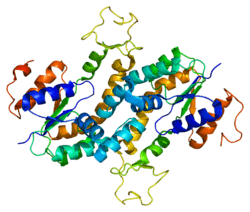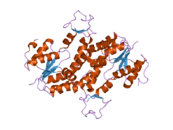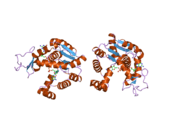AK3L1
| View/Edit Human | View/Edit Mouse |
Adenylate kinase isoenzyme 4, mitochondrial is an enzyme that in humans is encoded by the AK3L1 gene.[3][4]
This gene encodes a member of the adenylate kinase family of enzymes. The encoded protein is localized to the mitochondrial matrix. Adenylate kinases regulate the adenine and guanine nucleotide compositions within a cell by catalyzing the reversible transfer of phosphate group among these nucleotides. Five isozymes of adenylate kinase have been identified in vertebrates. Expression of these isozymes is tissue-specific and developmentally regulated. A pseudogene for this gene has been located on chromosome 17. Three transcript variants encoding the same protein have been identified for this gene. Sequence alignment suggests that the gene defined by NM_013410, NM_203464, and NM_001005353 is located on chromosome 1.[4] Expression of AK4 may regulate global cellular ATP levels and modulate the AMPK signaling pathway.[5]
References
- ↑ "Human PubMed Reference:".
- ↑ "Mouse PubMed Reference:".
- ↑ Noma T, Fujisawa K, Yamashiro Y, Shinohara M, Nakazawa A, Gondo T, Ishihara T, Yoshinobu K (Aug 2001). "Structure and expression of human mitochondrial adenylate kinase targeted to the mitochondrial matrix". Biochem J. 358 (Pt 1): 225–32. doi:10.1042/0264-6021:3580225. PMC 1222051
 . PMID 11485571.
. PMID 11485571. - 1 2 "Entrez Gene: AK3L1 adenylate kinase 3-like 1".
- ↑ Lanning, NJ; Looyenga, BD; Kauffman, AL; Niemi, NM; Sudderth, J; DeBerardinis, RJ; MacKeigan, JP (May 8, 2014). "A Mitochondrial RNAi Screen Defines Cellular Bioenergetic Determinants and Identifies an Adenylate Kinase as a Key Regulator of ATP Levels". Cell Reports. 7 (3): 907–917. doi:10.1016/j.celrep.2014.03.065. PMID 24767988.
External links
- Human AK3 genome location and AK3 gene details page in the UCSC Genome Browser.
- Human AK4 genome location and AK4 gene details page in the UCSC Genome Browser.
Further reading
- Povey S, Slaughter CA, Wilson DE, et al. (1976). "Evidence for the assignment of the loci AK1, AK3 and ACONs to chromosome 9 in man.". Ann. Hum. Genet. 39 (4): 413–22. doi:10.1111/j.1469-1809.1976.tb00145.x. PMID 182062.
- Xu G, O'Connell P, Stevens J, White R (1992). "Characterization of human adenylate kinase 3 (AK3) cDNA and mapping of the AK3 pseudogene to an intron of the NF1 gene.". Genomics. 13 (3): 537–42. doi:10.1016/0888-7543(92)90122-9. PMID 1639383.
- Robson EB, Meera Khan P (1983). "Report of the committee on the genetic constitution of chromosomes 7, 8, and 9. Oslo Conference (1981): Sixth International Workshop on Human Gene Mapping.". Cytogenet. Cell Genet. 32 (1-4): 144–52. doi:10.1159/000131694. PMID 7140357.
- Nobumoto M, Yamada M, Song S, et al. (1998). "Mechanism of mitochondrial import of adenylate kinase isozymes.". J. Biochem. 123 (1): 128–35. doi:10.1093/oxfordjournals.jbchem.a021899. PMID 9504419.
- Yoneda T, Sato M, Maeda M, Takagi H (1999). "Identification of a novel adenylate kinase system in the brain: cloning of the fourth adenylate kinase.". Brain Res. Mol. Brain Res. 62 (2): 187–95. doi:10.1016/S0169-328X(98)00249-6. PMID 9813319.
- Noma T, Adachi N, Nakazawa A (1999). "Cloning and functional characterization of the promoter region of the gene encoding human adenylate kinase isozyme 3.". Biochem. Biophys. Res. Commun. 264 (3): 990–7. doi:10.1006/bbrc.1999.1616. PMID 10544043.
- Strausberg RL, Feingold EA, Grouse LH, et al. (2003). "Generation and initial analysis of more than 15,000 full-length human and mouse cDNA sequences.". Proc. Natl. Acad. Sci. U.S.A. 99 (26): 16899–903. doi:10.1073/pnas.242603899. PMC 139241
 . PMID 12477932.
. PMID 12477932. - Gerhard DS, Wagner L, Feingold EA, et al. (2004). "The status, quality, and expansion of the NIH full-length cDNA project: the Mammalian Gene Collection (MGC).". Genome Res. 14 (10B): 2121–7. doi:10.1101/gr.2596504. PMC 528928
 . PMID 15489334.
. PMID 15489334.


